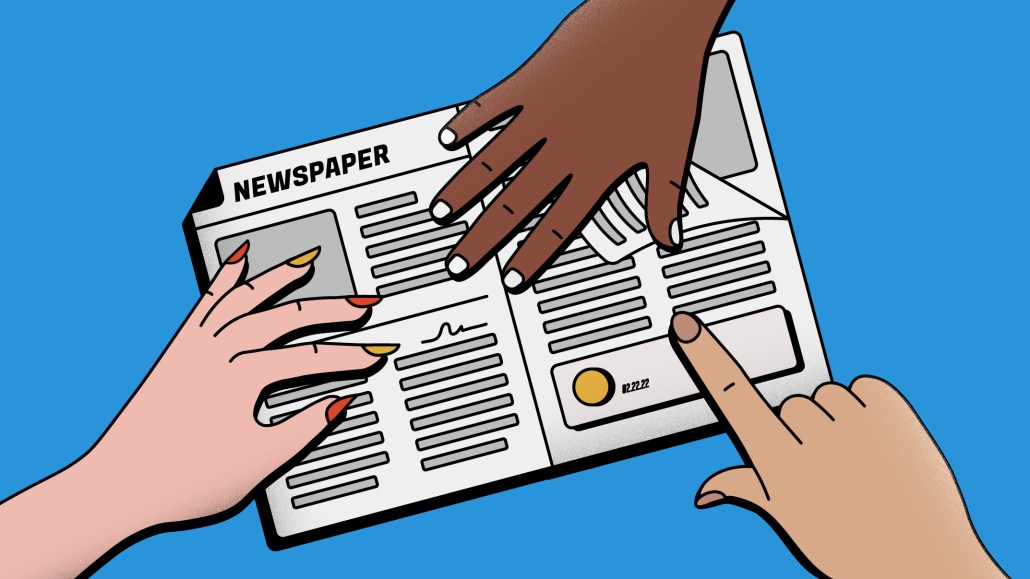Why digital clutter is driving brands to rethink the value of newspapers advertising

Last month, General Electric took over The New York Times’ print advertising for a day throughout the news, business and arts sections of the paper amounting to 22 full-page color ads as well as five partial pages.
The newspaper ads were meant to not only get readers’ attention in print but also cultivate chatter on social media about the brand. (The Times has never had a print or digital advertising space owned by one advertiser before.) It’s not clear how much GE paid for its takeover.
GE isn’t alone in wanting to get more attention from newspaper ads recently. Other brands like Equinox and Take 5 Oil as well as agencies like TBWA New York have taken a similar approach hoping newspaper ads generate social media buzz in an ever-more cluttered digital environment. (Equinox, Take 5 Oil, and General Electric — and its agency Giant Spoon — declined to answer follow-up questions from Digiday. The New York Times did not immediately respond to a request for comment.)
“It’s the power of doing something in print, making the statement, getting the logic right, and then knowing that it’s going to go viral,” said Rob Schwartz, chairman at TBWA New York Group, who added that creativity of a print ad is the strategy for brands to keep its readers’ attention before turning the page.
The cost of print
Schwartz estimated that a brand would need between $25,000 to $125,000 for the cost of running one full-page advertisement in a major newspaper, which is the same range that TBWA paid for its “Last Ad from the Last Big Ad Agency on Madison Avenue” full-page ad in The Times. The ad, which ran on Jan. 19, advertised the agency’s move to a different location in Manhattan. When it comes to print ads, Schwartz believes that it is less about money and more about making a statement.
“Sometimes it’s hard to kind of have the gravitas of the statement as a tweet,” said Schwartz, who noted readers’ affinity for taking pictures of print ads and sharing them over social media. “And if the ad itself is provocative or worth viewing, social media gives the ad a chance of widening the circulation.”
As previously reported by Digiday, marketers have been giving more traditional advertising tactics like out-of-home a second look as they seek out more tried and true methods amid the economic downturn. At the same time, the ever-growing digital ad market is getting increasingly cluttered, making it more difficult for marketers to stand out.
The favorability of the QR code can also change a print ad experience — which can be used to bring a newspaper reader to the brand’s website or app. Recent brands such as Skkn by Kim and American Express have used QR codes to connect online users to products in its physical locations.
Print ads are good for direct-response ads so readers can easily keep any phone numbers, said Sherri Rosenberg, vp of media at Blue Chip, an integrated marketing agency, as it’s much easier for people to recall the number in print as opposed to a video or digital OOH.
“The lead time is low, production costs are minimal, and CPMs are low and that makes newspapers good for time-sensitive information,” said Rosenberg. For The New York Times, the average cost for a full page ad is $47 CPM — or $3,500 for four weeks, according to its most recent pricing. “There’s greater reach when ads can be in both print and digital editions and brands can count on reaching business audiences from investors to potential partners.”
Carlos Ariza, SVP, integrated media, at the ad agency 9thWonder, echoed that sentiment, adding that part of the appeal could be the “trusted voice” of a publication.
This could change, too, with new readers’ preferences. A survey conducted by MarketingProfs in 2020 found that 92% of 18-to-23 year-olds find it easier to read printed material than digital information. Furthermore, the same study found that direct marketing campaigns are 37% more likely to generate a response than email campaigns. Compared with digital advertisements, consumers found print advertisements to be 34% more trustworthy.
According to Mat Zucker, senior partner and co-head of marketing and sales at Prophet, a growth strategy consulting firm, newspapers can also be used as corporate communications — defining your role in relation to an issue that arises in the market, also adding as a medium, it has gravitas, which may make it more appropriate for the CEO to deliver a message than say a more commercial based message.
It was also pointed out by Zucker that employees read newspapers too, so the newspapers can be purchased quickly when last-minute deadlines are approaching and are easy to navigate if there are last-minute changes or choices to be made. They also allow employers to do local targeting where the employees live.
“Full-page ads command attention and gravitas for the message,” said Zucker. “There’s no need to fill the space but the statement says we mean what we’re saying and it owns the space preventing clutter from other marketers or messages which could cloud the message or distract from it.”
More in Marketing

How brands shifted marketing and media strategies through year of tariffs
Marketers share how they navigated the maze of tariffs and regulatory changes this year.

Despite the hype, agentic AI isn’t ready to take the brand controls just yet
Despite agentic AI boosting content creation speed, human oversight remains critical due to concerns over hallucination, brand consistency.

Starbucks hires first-of-its-kind marketing role heading up fashion and beauty collabs
Neiv Toledano has joined Starbucks as its senior marketing manager of fashion and beauty.








